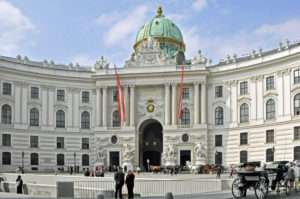
Exterior of Spanish Riding School in Vienna, Austria (Photo by Don Knebel)
In about 1562, Archduke Maximillian, a member of the Habsburg family who later became Holy Roman Emperor Maximillian II, set out to create the best fighting horses in the world for the empire’s cavalry. He started with horses from Spain that had descended from those used by the Berbers from North Africa in conquering most of the Iberian Peninsula beginning in 712 A.D. Maximillian crossbred the Spanish horses with those from northern Europe in the town of Lipizza, now in Slovenia. The resulting breed, combining elegance, strength and the ability to learn complex maneuvers, became known as Lipizzan or Lipizzaner.
In 1572, then Emperor Maximillian established a school to train the Lipizzaner horses for battle, using methods originating in fifth century B.C. Greece. The name, Spanish Riding School, recognized the horses’ origins. Initially, the horses were trained in a wooden arena in the Hofburg palace complex of the Habsburgs adjacent Josefsplatz in central Vienna. In 1729, Holy Roman Emperor Charles VI commissioned a magnificent new hall near Vienna’ Michaelerplatz for the now famous school. Empress Maria Theresa used the baroque-style white building, with two enormous crystal chandeliers and two tiers of seats, for public competitions and masked balls. Beethoven once conducted a concert in the hall using 1000 musicians. In 1848, after the Austrian revolution, Austria’s first representative assembly met in the Spanish Riding School building.
During the days of the Habsburgs, only the royal family and its guests could observe the training and performances of the Lipizzaner horses, all stallions. Today, performances are open to the public. The riders, once all men, have included women since 2008.
Comments are closed.